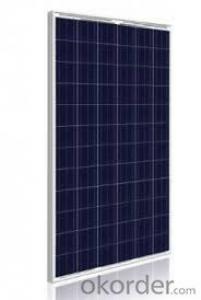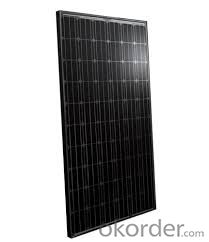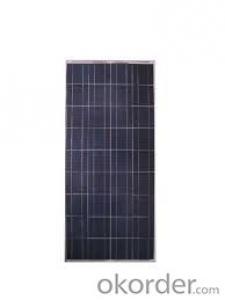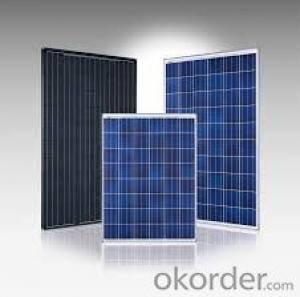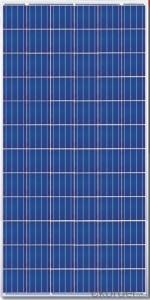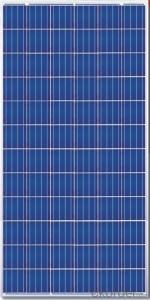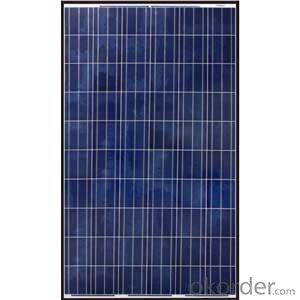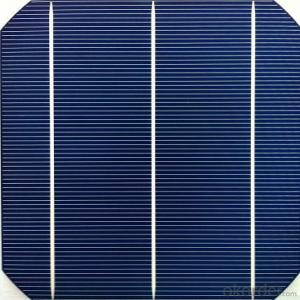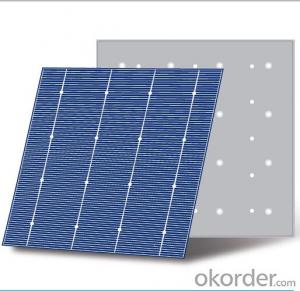235W Bendable Solar Cells Poly Solar Panel with Factory Direct Sale CNBM
- Loading Port:
- Qingdao
- Payment Terms:
- TT OR LC
- Min Order Qty:
- 10 set
- Supply Capability:
- 300000 set/month
OKorder Service Pledge
OKorder Financial Service
You Might Also Like
Polycrystalline Solar Modules
CNBM offers a range of small, medium and large polycrystalline solar modules, designed for a range of requirements.
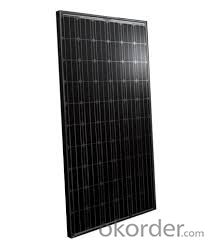
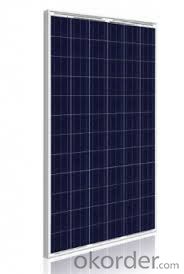
Specifications:
Tolerance | +/-3% |
Cell | Polycrystalline silicon solar cells (156 x 156mm) |
N0. of Cells | 60 (10 x 6) |
Dimension of Modules (mm) | 1650 x 990 x 40 |
Weight (kg) | 25.5 |
Limits:
Operating Temperature | -40~+85? |
Storage Temperature | -40~+85? |
Maximum System Voltage | 1000 VDC max. |
Hail Impact | Diameter of 28mm with impact speed |
Temperature and Coefficients:
NOCT | 48C+/-2? |
Voltage temperature coefficient (%/K) | -0.35 |
Current temperature coefficient (%/K) | 0.05 |
Power temperature coefficient (%/K) | -0.45 |
Characteristics:
Model: | SGM-200P | SGM-210P | SGM-220P |
Max-power voltage Vmp (V) | 29.2 | 29.4 | 29.41 |
Max-power current Imp (A) | 6.85 | 7.14 | 7.48 |
Open-circuit voltage Voc (V) | 36.5 | 36.69 | 36.9 |
Short-Circuit Current Isc (A) | 7.28 | 7.6 | 7.93 |
Max-power Pm(W) | 200 | 210 | 220 |
Model: | SGM-230P |
Max-power voltage Vmp (V) | 29.8 |
Max-power current Imp (A) | 7.72 |
Open-circuit voltage Voc (V) | 37.31 |
Short-Circuit Current Isc (A) | 8.19 |
Max-power Pm(W) | 230 |
STC: Irradiance 1000W/m2, module temperature 25?, AM-=1.5
Poly Crystalline Solar Panels Specifications Range
Maximum Power (Pm) | Dimension | Weight | Operating Voltage (Vmp) | Operating Current (Imp) | Open Circuit Voltage (Voc) | Short Circuit Current (Isc) |
0.45W | 140x80x10mm | 0.08kg | 3.3V | 150mA | 4.6V | 160mA |
1.0W | 162x140x10mm | 0.16kg | 7.5V | 150mA | 10.3V | 160mA |
4.5W | 269x251x23mm | 0.8kg | 16.5V | 0.27A | 20.5V | 0.3A |
10W | 420.1×268.9×22.6mm | 1.92kg | 17.5V | 0.58A | 20.5V | 0.6A |
20W | 425x502x50mm | 3.0kg | 16.8V | 1.19A | 21.0V | 1.29A |
30W | 593x502x22.6mm | 3.9kg | 16.8V | 1.78A | 21.0V | 1.94A |
40W | 655x537x50mm | 5.75kg | 17.3V | 2.31A | 22.1V | 2.54A |
50W | 839x537x50mm | 6.0kg | 17.5V | 2.9A | 21.8V | 3.17A |
65W | 1111x502x50mm | 7.2kg | 17.6V | 3.69A | 22.1V | 3.99A |
80W | 1204x537x50mm | 7.7kg | 17.6V | 4.55A | 22.1V | 4.8A |
- Q: Can solar cells be used in indoor lighting applications?
- Yes, solar cells can be used in indoor lighting applications. However, their effectiveness may vary depending on the amount of sunlight available indoors.
- Q: What is the impact of fire hazards on solar cells?
- The impact of fire hazards on solar cells can be significant and detrimental. Fires can cause direct damage to the cells, resulting in their complete destruction or impaired performance. The high temperatures and flames associated with fires can melt or warp the delicate components of solar cells, rendering them useless. Additionally, the smoke and ash produced by fires can settle on the surface of the solar panels, reducing their efficiency by blocking sunlight. Therefore, fire hazards pose a significant risk to the functionality and longevity of solar cells.
- Q: How do solar cells perform in areas with high winds?
- Solar cells can perform well in areas with high winds as long as they are properly installed and secured. However, excessive wind speeds can potentially damage or displace the solar panels, affecting their efficiency. To mitigate this, appropriate mounting systems and anchoring techniques can be used to ensure the stability and durability of solar installations in windy areas.
- Q: How do solar cells perform in areas with high levels of bird droppings?
- Solar cells can be negatively affected by bird droppings in areas with high levels of bird activity. The droppings can block sunlight, reducing the efficiency of the solar cells and potentially leading to decreased power output. Regular cleaning and maintenance are essential to ensure optimal performance in such areas.
- Q: Can solar cells be used for powering remote sensors?
- Yes, solar cells can be used for powering remote sensors. Solar cells convert sunlight into electricity, making them an ideal power source for remote sensors in locations where access to a power grid is limited or non-existent. This enables continuous operation of the sensors without the need for frequent battery replacements, making solar cells an efficient and sustainable solution for powering remote sensors.
- Q: Can solar cells be used for powering schools?
- Yes, solar cells can be used for powering schools. Solar panels can be installed on rooftops or in open spaces near the school to capture sunlight and convert it into electricity. This renewable energy source can help meet the energy needs of schools, reducing their reliance on fossil fuels and lowering their carbon footprint. Additionally, solar power can provide a reliable and cost-effective source of electricity for schools, allowing them to save on energy expenses in the long run.
- Q: What is the impact of solar cell installations on local economies?
- Solar cell installations can have a positive impact on local economies. Firstly, they create job opportunities in the installation, manufacturing, and maintenance sectors. This leads to a boost in employment rates and income generation within the community. Additionally, solar energy reduces reliance on imported fossil fuels, resulting in cost savings for both households and businesses. As a result, more money remains in the local economy, stimulating growth and supporting local businesses. Moreover, solar installations can attract investments and businesses looking to align with sustainable practices, further fueling economic development. Overall, solar cell installations contribute to job creation, cost savings, and increased investment, making a significant positive impact on local economies.
- Q: How are solar cells integrated into building designs?
- Solar cells can be integrated into building designs in several ways. One common method is to install solar panels or modules on the roof, which capture sunlight and convert it into electricity. These panels can be mounted on top of the roof or integrated into the roofing material itself. Another approach is to incorporate solar cells into windows or building facades, creating solar glazing that generates electricity while still allowing natural light to enter the building. Additionally, solar cells can be integrated into shading devices such as awnings or louvers, providing both energy generation and sun control. Overall, integrating solar cells into building designs allows for the efficient utilization of renewable energy and reduces dependency on traditional power sources.
- Q: Can solar cells be used in grid-tied systems?
- Yes, solar cells can be used in grid-tied systems. Grid-tied systems, also known as grid-connected or grid-interconnected systems, allow solar energy to be generated and used simultaneously with the utility grid. Solar cells, which convert sunlight into electricity, can be integrated into these systems to generate clean and renewable energy that can be fed into the grid, offsetting the use of conventional power sources and potentially earning credits or incentives.
- Q: Can solar cells be used for powering offshore oil rigs?
- Yes, solar cells can be used for powering offshore oil rigs. They can provide a renewable and clean energy source to supplement or replace traditional fossil fuel-based generators, reducing the environmental impact and operational costs of offshore oil operations.
Send your message to us
235W Bendable Solar Cells Poly Solar Panel with Factory Direct Sale CNBM
- Loading Port:
- Qingdao
- Payment Terms:
- TT OR LC
- Min Order Qty:
- 10 set
- Supply Capability:
- 300000 set/month
OKorder Service Pledge
OKorder Financial Service
Similar products
Hot products
Hot Searches
Related keywords
